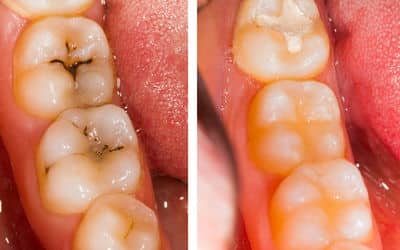A dental filling restores function and strength to a tooth. It can be white or silver in colour.
Why do I need dental fillings?
Reasons include:
- Cavities or holes in teeth
- Fractured teeth as a result of an accident or trauma.
- Broken a tooth while chewing.
- A chipped tooth.
- A cracked tooth.
Cavities will become large if they are not treated. Germs will enter the dental pulp or nerve canal and infect the tooth. This will result in a toothache which can be a dull ache or an unbearable, throbbing pain.
If this happens, we may have to extract the tooth or do a root canal treatment.
If you want to treat broken or decayed teeth, the dentist will place fillings to strengthen them. This will improve your smile, speech and chewing. Tooth bonding is another option to strengthen the teeth. Bonding involves placing filling material and using a special light to harden the material. The material bonds to the tooth structure and provides strength.
To prevent dental problems, our Bendigo dentist recommends you visit us every six months. In your dental check-up, we will check all your teeth and mouth. If we find holes, we will be able to fill them and prevent future discomfort.
What types of filling materials are available?
The two main types are:
1. Tooth coloured or white fillings:
We use tooth coloured fillings on front and back teeth. The materials that we use are composite and glass ionomer cement.

The main advantages of using these composite filling materials are:
- – The dentist can match the exact or close to exact colour of your teeth.
- – The dental professional has to remove less tooth structure as they use a special glue or bonding material to stick the white material to the teeth.
- The disadvantages of using white fillings are that they:
- – Are not as strong as silver fillings.
- – May stain or discolour after some time.
- -Can break or chip so may need regular maintenance.
2. Silver coloured or amalgam fillings:
Amalgam fillings consist of various metals such as silver, copper, zinc and a small and safe amount of mercury. We mainly place this type of filling on back teeth.
The main advantages of using amalgam are that they are much stronger and will last longer than white fillings. The disadvantage is the silver colour.
Are amalgam fillings safe?
While amalgam contains a tiny amount of mercury, this is safe to place in the mouth.
A large body of research from various governments and universities proves mercury in amalgam fillings does not cause toxicity. The amount of mercury in amalgam filling is very small and not enough to cause mercury poising.
Additionally, some foods contain mercury which is absorbed into the body when consumed. Further, burning of fossil fuels produces mercury, which is released into the air.
Amalgam fillings are therefore safe to place in the mouth.
Why do dental fillings break?
1. The materials become old and lose their properties.
2. Fillings are large which can mean inadequate tooth support.
3. If you have a heavy bite, it can impact the filling.
5. Clenching teeth while sleeping.
If a dental filling breaks, what are my other options?
- For fillings that break very often, dental crowns are the best option
- If you chip your fillings frequently, porcelain veneers are the best option.